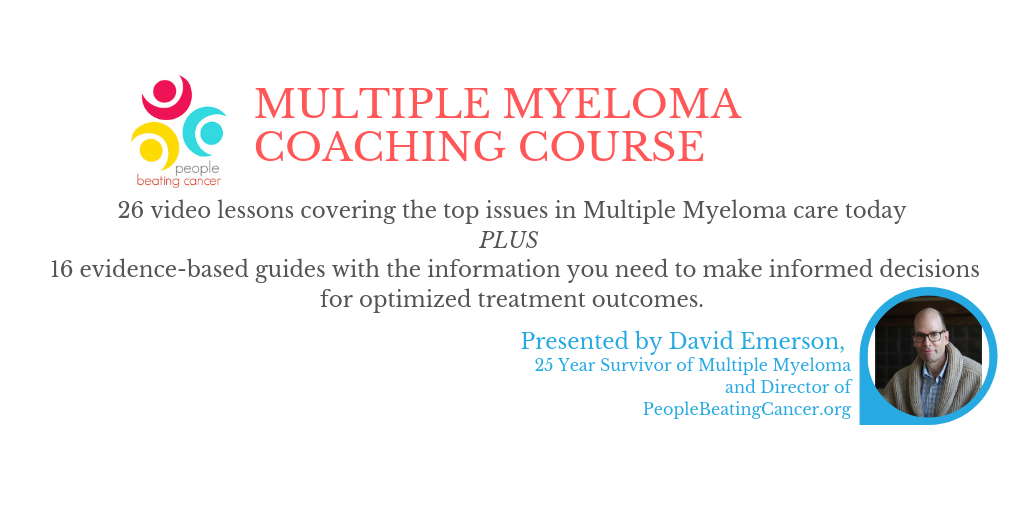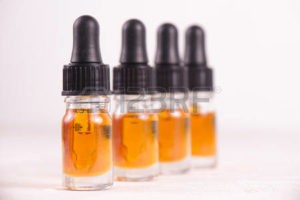
Recently Diagnosed or Relapsed? Stop Looking For a Miracle Cure, and Use Evidence-Based Therapies To Enhance Your Treatment and Prolong Your Remission
Multiple Myeloma an incurable disease, but I have spent the last 25 years in remission using a blend of conventional oncology and evidence-based nutrition, supplementation, and lifestyle therapies from peer-reviewed studies that your oncologist probably hasn't told you about.
Click the orange button to the right to learn more about what you can start doing today.
- You are here:
- Home »
- Blog »
- Multiple Myeloma »
- Multiple Myeloma Cancer Coaching Q & A
Multiple Myeloma Cancer Coaching Q & A

“The bone marrow microenvironment in multiple myeloma is characterized by an increased microvessel density. The production of pro-angiogenic molecules is increased and the production of angiogenic inhibitors is suppressed…”
Hi David- I’ve finished the multiple myeloma cancer coaching course and have really enjoyed all the new information and perspectives. So many questions have come into my mind, and I wonder if you can answer any of them for me:
- Do you take CBD? The evidence is pretty good and my wife is going to begin on it as it is freely available here. Following a very successful stem cell harvest, Debbie’s transplant has been delayed (by COVID-19) for some months, so a bit of Lenalidomide or Velcade or whatever plus supplements/non-conventional therapies are her way forward for now….if this is effective, she’ll resist an ASCT for as long as possible (you’re absolutely right David about the toxicity and collateral damage of high-dose Melphalan!)
- Since you went so thoroughly into taking alternative remedies/supplements, have your M Spike levels fluctuated? If so, do you adjust any of your doses?
- Have you had any difficulty coping with DHEA? It has a reputation for being tough on the liver.
- How have people you have helped fared in managing their Myeloma?
I have come across a fascinating Norwegian paper on home-made garlic extract [GE]. It found that:
GE inhibits growth of several different cancer cells in vitro, as well as cancer growth in vivo in a syngeneic orthotopic breast cancer model. Multiple myeloma cells were found to be especially sensitive to GE.
I like the word especially. The paper includes a simple recipe for making the garlic extract at home.
That’s all for now David! Wishing you continued health and vigor to keep up the great work!
Hi Dan-
I will reply to your questions below.
- Do you take CBD?
Not yet. My state (Ohio) allows the use of CBD for medical purposes but the dispensaries are not established yet.
2. has your M Spike levels fluctuated?
Once I went into complete remission in early 1999, I have remained stable. My numbers have always been normal.
3. Have you had any difficulty coping with DHEA?
I check my kidney function regularly and testing has never indicated any problems with my kidney health.
4. How have people you have helped fared in managing their Myeloma?
MM CC clients vary widely. I work with the spectrum of MM patients from pre-MM (mgus, smm) to relapsed/refractory. From young (50ies) to elderly (80ies).
I would love to tell you that I help all MM patients, survivors and caregivers but I just can’t track the specifics.
As for garlic and MM, all I can say is that garlic is anti-angiogenic and therefore inhibits MM. Our studies below support each other. Thank you.
You and your wife stay well.
David Emerson
- MM Survivor
- MM Cancer Coach
- Director PeopleBeatingCancer
Recommended Reading:
- Surviving Multiple Myeloma- Post-Cancer Fear
- A Long-term Multiple Myeloma Survivor’s Diet, Nutrition Plan-
- Multiple Myeloma Side Effects- Prevent, Heal Chemobrain
Angiogenesis and Multiple Myeloma
“The bone marrow microenvironment in multiple myeloma is characterized by an increased microvessel density. The production of pro-angiogenic molecules is increased and the production of angiogenic inhibitors is suppressed, leading to an “angiogenic switch”.
Here we present an overview of the role of angiogenesis in multiple myeloma, the pro-angiogenic factors produced by myeloma cells and the microenvironment, and the mechanisms involved in the myeloma-induced angiogenic switch.
Current data suggest that the increased bone marrow angiogenesis in multiple myeloma is due to the aberrant expression of angiogenic factors by myeloma cells, the subsequent increase in pro-angiogenic activity of normal plasma cells as a result of myeloma cell angiogenic activity, and the increased number of plasma cells overall.
Anti-angiogenesis efficacy of the garlic ingredient alliin and antioxidants: role of nitric oxide and p53
“Alliin, a compound derived from garlic, demonstrated dose-dependent inhibition of fibroblast growth factor-2 (FGF2)-induced human endothelial cell (EC) tube formation and angiogenesis in the chick chorioallantoic membrane (CAM) model…
These data indicated a synergistic effect of antioxidants on the anti-angiogenesis and anticancer efficacy of alliin. These data also suggest the implication of cellular NO and p53 as mediators of anti-angiogenesis and anticancer effects of alliin.
Anti-Cancer Potential of Homemade Fresh Garlic Extract Is Related to Increased Endoplasmic Reticulum Stress
3.1. Garlic Extract Reduces Cell Growth of Multiple Myeloma and Prostate Cancer Cells
The homemade GE was found to reduce the viability of the two multiple myeloma (MM) cell lines, RPMI-8226 and JJN3, as well as the prostate cancer cell line DU145 in a dose-dependent manner, while the growth of the osteosarcoma cell line U2OS was not affected at the same doses (Figure 1A–D).
Treatment with 22% ethanol alone (final ethanol concentration in GE), diluted 1:50 in growth media, had no effect on the viability. These results illustrate variations in sensitivity toward GE for different cancer cell lines, and suggest that MM cells are hypersensitive to GE.
We next tested the ability of GE to induce apoptosis in non-proliferating primary MM cells, co-cultured with bone marrow stromal cells in a BMSC-assay [28,34].
Interestingly, GE diluted up to 8000 times reduced the viability of primary MM cells, while not affecting the BMSC in the co-culture (part of the assay criteria) (Figure 1E). These results further support that MM cells are hypersensitive to GE.
3.7. Concluding Remarks
The beneficial effects of garlic have been known for centuries, and our understanding of the molecular mechanisms that underlay these effects is steadily increasing. Here, we show that a homemade garlic extract has anti-cancer activities both in vitro and in vivo, and that the activity is stable for more than six months if stored in a freezer.
In agreement with multiple recent studies, our data support a mechanism by which OSCs in GE trigger apoptosis, via ER stress and effects on the cellular redox regulation. However, the molecular mechanisms of the anti-cancer effects mediated by garlic are highly complex, and likely different in different cancer cells.

